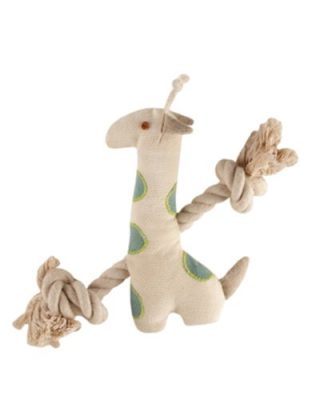
Written by Suzanne, Chief Health Officer and Resident Grandmother
In January of 2018, instead of making the usual resolutions that we’ve given up on by the end of the month, we decided to break it up by dividing some big goals into manageable chunks.
Each month, we invite you to overhaul one aspect of your life to reduce toxins, improve health, and increase your peace of mind. Our promise is that these changes will be easy to implement, helping you avoid resolution overwhelm.
(If you’re just joining us, here is January’s mini resolution on upgrading junk foods, February’s with a medicine cabinet detox, March’s on improving indoor air quality, April’s five ways to clean up your cleaning products, May’s on making your yard non-toxic, June’s on water safety, and July’s on natural skincare products.)
This August, we turn our attention away from the humans in your home to focus on your dogs. (If you don’t have a dog, you get this month off!).
As many of you know, we got a puppy a little over a year ago. I did a lot of research before we got him on the best breeds for families with young children, rescue vs. purebred dogs, diet, lifestyle, and how to be a holistic, conscious pet owner. My key takeaways follow.
How to Improve Your Dog’s Health

1. Feed Your Dog a Species-Appropriate Diet
No surprise here: my number 1 tip is about what you feed your dog. Namely, I encourage you to switch to a species-appropriate diet.
A species-appropriate diet for a dog is one consisting of raw, whole foods similar to those eaten by the dogs’ wild ancestors. The food must contain such things as muscle meat, bone, fat, organ meats, vegetables, and fruits, combined in precisely the correct balance with high protein and plenty of moisture.
The problem with kibble (dry dog food) is the moisture content is way too low and the dog is always dehydrated. Over time, a dog can develop kidney problems, skin problems, allergies, etc.
You can research raw diets to make at home; this one meets the criteria for a balanced high-protein diet.
I spend enough time cooking for my family. I don’t want to also be cooking dog food. BARF (Biologically Appropriate Raw Food) is easy and convenient, and a holistic approach to common health problems for dogs. We are amazed that Koa sheds very little and his coat looks silky and smooth. He also doesn’t have any skin issues, which our old dog did have.
BARF’s frozen 8-ounce patties offer a variety of protein sources–beef, chicken, and lamb–each with a particular targeted benefit to enhance your pet’s health. Koa is weird and likes to eat his patties frozen. You can also thaw them in the fridge and give them to your dog. If you would like to feed your dog the BARF diet, here is the link to purchase.
2. Find a Holistic Vet
Taking Koa to a holistic veteranarian has been a game-changer for us. Our vet holds our same values on health and yet has a a traditional medical background.
For example, she understands my concern about so many vaccines and works with us on which ones he needs at any given visit. She performed blood work to check for titers before giving Koa a distemper shot last year. He was due for another, but his titers test showed that he had immunity and therefore we could skip the shot.
(A titer test is a laboratory test measuring the existence and level of antibodies to disease in blood. Antibodies are produced when an antigen (like a virus or bacteria) provokes a response from the immune system. This response can come from natural exposure or from vaccination.)
Our vet also offers the oral kennel cough vaccine, which is less toxic than the shot.
3. Give your dog only non-toxic toys
There no regulations on what dog toys can be made of, so it can be tough to find toys that are non-toxic. Like children’s teethers, pet toys often contain hormone-disrupting phthalates or BPA, so look for brands that make toys from fabrics, FDA-approved plastic (meaning humans can eat off of it), or–better yet–silicone.


$3.99Buy Now

(Koa loves this ball!)

$18.99Buy Now
$12.00Buy Now
4. Invest in a non-toxic doggy bed.
Your dog’s bed is probably introducing toxins into your home–and your dog himself also spends lots of time there! Many pet owners have also discovered that their dogs have allergies or skin irritations, which can be exacerbated by microfiber and polypill beds.
Soaring Heart’s organic Doggie Dream Beds are handcrafted, made of out of equal parts 100% organic GOLS-certified Dunlop latex shred, 100% organic American-grown long-fiber cotton, and organic wool. In addition, Soaring Heart’s extra thick dog beds raises the dog well off the ground, reducing stress on joints and allowing plenty of “nesting” room.
$273.25Buy Now
5. Use Non-Toxic Dog Shampoo
There is actually an odd dearth of truly non-toxic pet grooming supplies, but we like Eco-Me’s line of natural shampoos and detanglers.
6. Shower Your Dog with Attention & Exercise

We take Koa on two walks a day, which is a major time commitment, I admit!
The walk in the morning is off-leash by the river, where he can swim, frolic, and play. The one in the afternoon is walking in our neighborhood on leash.
He has been trained with treats to walk on-leash loosely without pulling. Other times in the yard, we play toss the ball, chase the stick, or engage in small training sessions. (Any training session should not be longer than two or three minutes. Dogs like variety so that they don’t get bored and mischievous.)
7. Engage in Positive Training

Dogs, like kids, need guidelines and boundaries. Just like kids, they are happier with good leadership.
What helped me with this is signing up with a good trainer who uses Science-Based Positive Reinforcement Dog Training. Koa has taken classes on puppy manners, puppy kindergarten, and puppy junior high!
Taking place in classes really helps me focus on his training. Good leaders are kind and fair–not bullies. Be patient, reward behaviors you like and ignore behaviors that you don’t like. By this I mean, don’t reward him with attention if he misbehaves!

Wolfie, age 4, teaching Koa to sit.
To your and your pet’s health,

P.S. If you like the gorgeous portrait above (of our late dog, Mele): it was painted by my talented son, Graham. Email him if you’d like to talk to him about painting a portrait of your special animal!
If you liked this post, sign up for our newsletter to be alerted when we publish new content like this!














Tobi says
Do you have any recommendation on flea and tick prevention? It seems necessary but the main brands seem so toxic, and DIY doesn’t sound like it is all that effective.
Maia James says
Hi Tobi, This is a very difficult question that we struggled with. We did use some natural herbal tick spray repellents when he was a small puppy but after talked to our holistic vet about the risks she did recommend FrontLine which is a chemical. We weighed the risks and decided that because we live in a tick problem area in PA and we take him to the woods walking everyday that it was worth the risk. You can read the blog that my husband wrote about this a year ago. I don’t personally use anything but herbal repellents but different members of my family use different products. My husband and vet didn’t want to risk it with the dog. https://gimmethegoodstuff.org/ticks-do-non-toxic-repellents-work/
Veronica says
What about diatomaceous earth for flea and tick prevention!
Also neem powder
Some essential oils I can’t ememwbe which ones.
They have good recipes online for natural homemade flea tick prevention.
Suzanne Weaver-Goss says
We have used diatomaceous earth many times to get rid of ants. I’m not sure that it acts fast enough to stop a tick from exposing the host (you) to potential Lymes disease.